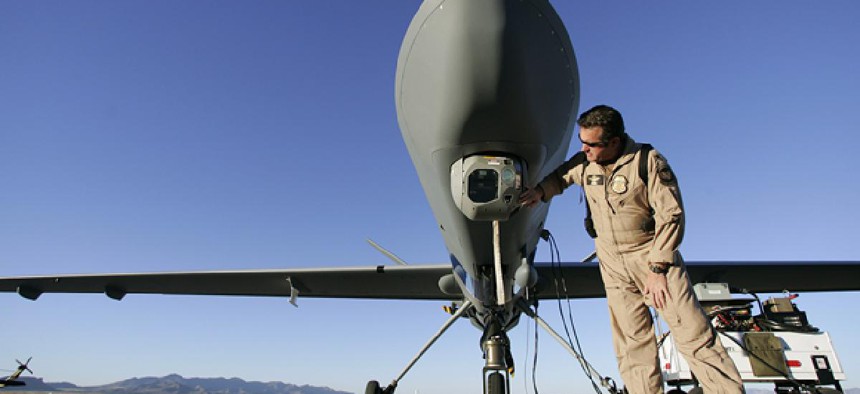Freeze border security drone purchases, IG says

Ross D. Franklin/AP file photo
Customs and Border Protection let its fleet sit idle 63 percent of the time the unmanned aircraft were supposed to be flying.
CBP’s fleet of remotely-piloted surveillance planes sit unused 63 percent of the time that the vehicles are supposed to be flying, according to a May 30 audit by the DHS inspector general. The nation’s stateside unmanned aircraft systems, or UASs, were commissioned, beginning in 2004, to detect terrorist activity, illegal immigration and smuggling across U.S. borders.
The inspector general recommended that CBP “postpone additional UAS purchases” until completing recommended planning papers.
Based on contract specifications, CBP’s seven drones should have been flying at least 10,662 hours per year, collectively, according to the inspector general’s calculations. The drones flew only 3,909 hours per year total, the report found.
“Despite the current underutilization of unmanned aircraft, CBP received two additional aircraft in late 2011 and was awaiting delivery of a tenth aircraft in 2012,” wrote Anne L. Richards, the Homeland Security Department’s assistant IG for audits. The unmanned aerial surveillance program covers the U.S. southwest, Caribbean, gulf and northern border regions.
CBP reported that between fiscal 2006 and 2011 the agency spent $55.3 million for drone operations and maintenance but never prepared an operations and maintenance budget for the program. “This has resulted in a budget shortfall,” Richards wrote, adding that CBP transferred about $25 million from other programs in fiscal 2010 to fill the financial gap. “As a result of CBP’s insufficient funding approach, future UAS missions may have to be curtailed,” she added.
The agency did not budget for drone-related equipment, either, according to the report. As a result, the Corpus Christi National Air Security Operations Center was missing a compatible ground control station for the “Predator” drone and had to borrow one from the Cocoa Beach operations center. In addition, on at least three occasions that lasted a total of 9 days, the Grand Forks operations center could not launch aircraft because maintenance tools were unavailable.
In response to a draft report, CBP officials said that the agency has documents that guide funding requests for operations, maintenance and equipment.
“Funding requests arc developed to support the [UAS program], but the actual funding provided to the program is subject to changing department and agency criteria,” James Tomsheck, assistant commissioner for the CBP internal affairs office, wrote in an April 4 letter to the Homeland Security inspector general. “CBP will continue to request adequate funding based on known and projected operational requirements while judiciously utilizing available resources to accomplish CBP's mission.”
The assistant inspector general said such planning materials are inadequate and not what was requested. “CBP’s comments do not appear to address the recommendation, which will remain open and unresolved until CBP provides specific documentation that details how it plans to achieve the [minimum flight hours expected] and acquire funding to provide necessary operations, maintenance, and equipment,” Richards wrote in the final report.
Responding to the recommendation that CBP halt drone procurements, agency officials said they do not currently have plans to acquire more aircraft, unless directed to do so by a higher authority.
The inspector general did not seem convinced that this answer meant CBP would postpone future drone buys. “CBP comments do not fully address the intent of the recommendation, because it indicated there are no plans to expand the UAS fleet,” Richards stated.
The agency has spent $152 million to acquire the nine vehicles currently in its inventory.
One way for CBP to obtain additional funding for drone support would be to rent its fleet to other federal agencies but the IG found it has not brokered agreements to obtain reimbursement from departments other than the Federal Emergency Management Agency. In the past, CBP’s drone program has aided Immigration and Customs Enforcement by monitoring a suspected smuggler tunnel. And the unmanned planes captured periodic images of flooded locations that allowed the National Guard to position high-water vehicles and sandbags where they were most needed.
In their written response to the audit, CBP officials said there already were ongoing efforts at Homeland Security to address the reimbursement issue.
On Tuesday afternoon, CBP officials said they had completed appropriate strategic planning for the program going forward that covers the inspector general’s budgetary recommendation. The agency does not currently have plans to purchase additional drones, they added.
“CBP’s Unmanned Aircraft System program provides command, control, communication, intelligence, surveillance, and reconnaissance capability to support personnel and capabilities on the ground,” CBP spokesman Michael Friel said in a statement. “CBP concurred with the recommendations in the inspector general’s report and is committed to continuing to improve the UAS program.”
After receiving the audit, some Democratic lawmakers chided the agency for letting drones sit unused.
“The agency is spending money without adequate or proper planning, resulting in expensive aircraft spending most of the time idle on the ground,” Rep. Bennie Thompson, D-Miss., ranking member on the Homeland Security Committee, said in a statement. “CBP must implement the OIG’s recommendations to ensure the UAS program makes [the most] out of taxpayer money and our border security budget. CBP must also institute procedures so that its programs have the proper planning in place.”



